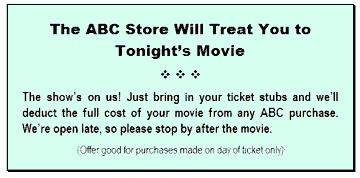|
|
|
Joint
Venture Marketing: How to Get Virtually Free Promotion for Your
Business Would you be interested in learning how to get tens of thousands of dollars of nearly free advertising and promotion for you and your company? No? OK. See you next month… Everybody else, listen up. Of course you'd like to know about a marketing strategy that's devastatingly effective, incredibly inexpensive, and reasonably easy to do. To kick off the New Year and make your 2004 the most successful ever, I'm going to teach you how to do marketing joint ventures with other businesses. It's an approach that may just give you the breakthrough you've been looking for. Joint Venture Marketing… Your Opportunity for New Profits.
The key concept behind neighborhood marketing is "free distribution." As you know, using paid media to distribute your advertising messages can be very expensive. Whether you use newspaper space, direct mail, radio spots, TV, billboards, or any other form of advertising, you're constantly balancing the cost of the medium versus the result it produces. Quite often, you can come out on the losing side of this equation. But all these media are just "delivery systems" to distribute your marketing message to the marketplace. What if you could tap into an alternative "free" delivery system? That's the goal of neighborhood marketing. In a nutshell, you put together an offer of free or discounted (or in some cases premium) merchandise and/or services. Then you find a marketing joint venture partner who'll present it to his or her customers as an additional benefit of doing business with that company or organization. Often, the most powerful joint ventures involve you supplying something of true value at no cost to the venture partner. However, few people have the ability to do this without getting severe heartburn. Perhaps this "marketing antacid" will help: Do You Know How Much it Costs You to Acquire a New Customer?
So, giving something away which costs you perhaps fifteen dollars to get a new shopper/buyer might make all the sense in the world… if it's handled properly. Moreover, with the approach I'll show you in this letter, you can be highly selective in targeting the kind of person you'll attract. I rarely suggest advertising a pure no-obligation give-away like this in mass media. Usually, you'll pull in the dregs… "bottom feeders" who'll come in just for the "freemium," never to be seen again. (Granted, you'll also attract some good guys, but it may be hard to serve them when the hordes have descended upon you.) But by structuring the right kind of cross-promotion, you can effectively filter out the cheapskates and opportunists. By the way, I'm using the example of a retail store in this article, but the concepts apply equally well to professional practices, B2B, services, et cetera. Of course, some tweaks may be required… So far so good, but… if you're interested in doing this You've Got to Think Long Term (and "Hands-on"). Also, if you're looking to nail down a promotion, and just run it over and over again without monitoring or changing anything, neighborhood marketing won't work for you; these campaigns usually have a limited lifespan. To be successful with this approach, you have to do a number of different things. No one promotion or one type of promotion can exploit all the potential that's in the market. If these limitations are acceptable to you, you've got some decisions to make. The first is, whom do you set this up with? Beyond the obvious choice of other neighborhood merchants, the Slutskys suggest nine additional avenues of free distribution: Ten Kinds of Joint Venture "Partners"
Each of these entities, of course, requires a different approach. Most of the focus of this article will be on working with retailers, but you'll see ways to extend the concept to the others quite readily Example Cross-Promotion: Movie Theater
If you can get them to also print or rubber-stamp this on the back of the tickets, so much the better. You can also play this another way, by arranging for a block of discount movie passes to give your paying customers. This won't cost much but will be sure to delight them. It's also a great way to break the ice with the theater manager. Three C's of Cross Promotion. For a "scientific" approach to neighborhood marketing, let's go over the three "C's" of cross-promotion: Cost, Control, and Credibility. The First C: Cost. The Second C: Control.
Geographic Control: It may not be the best idea to cross-promote with the business next door. Because of the close proximity, you may already share many of the same customers - who are already paying full price. However during slow seasons, it may still make sense to do it. The farther away the other business is, the greater the probability you'll get new customers. To get a handle on this, you should create a map of the neighborhood with all the stores listed by name. If I get enough requests, I'll write future Urbach Letter about using G.I.S. (Geographic Information Systems), including how to do a competitor and customer distribution analysis. Trust me; it's a lot more interesting than it sounds… Promotions are most effective when your marketing pieces are distributed by merchants whose geographic location is within a 3-5 mile radius from your store. Their customer demographics are compatible with yours, and their customer counts are significant. Demographic Control: We touched on this earlier. Clearly, you'll want to avoid merchants and organizations that cater to the low end of the marketplace. The goal of all good marketing is to identify your best existing customers and then "clone" them. Think about the other businesses your customers patronize – and which ones they don't. For example, a good number of your customers might shop at a nearby golf supply store or moor their boats at a local marina. It's unlikely your better customers will be stopping in at "Discount Sam's Closeout Shack" (but you never know…). Numerical Control: This means controlling the number of coupons that go out. For example, if a business has fewer than about a 100 weekly customers, it may not be worth setting up the promotion. Competitive Control: This "control" means that, most likely, competitors will not be monitoring your promotion. When you find something that works great, it's best to keep your competitors guessing why your store is so busy all the time! Synergistic Control: Synergy happens when you employ multiple forms of promotion simultaneously. Your print ads support your direct mail which supports your cross-promotion which supports referral program, etc., etc., etc. The Third C: Credibility. "As competition increases dramatically, consumers are barraged with all kinds of off-price marketing: coupons, sales, discount clubs, give-aways, and special financing are some ways of attracting customers. These devices condition a customer to wait for a deal before they buy. When a business puts a coupon in the paper every week, its customers come to expect that coupon. With a cross-promotion, you can give someone else the credit for the deal you're offering." What's nice about marketing joint ventures is that you can protect your price credibility by transferring the responsibility for a discount to your cross-promotion partner. Other type of credibility is testimonial credibility. Because your cross-promotion partner is already respected by his or her customers (otherwise they'd buy from somebody else), the fact that he or she is handing out your promotion pieces infers an endorsement of you and your store. It's an implicit testimonial. How to Set Up a Promotion Start by identifying merchants to approach. The best choices are often those who are already your customers. There are 3 advantages:
If you want to cast a wide net, you can identify business customers by having a business-card drawing in a fish bowl. You can also identify potential business partners by driving through the neighborhood, taking different routes to work. Once you've compiled a list, pick out approximately 10 whom you already know. The selection should be made based on these 4 criteria: The partner should:
Ten Steps for Setting Up a Cross Promotion: 1. Make contact with the potential JV partner (but be low key about it). 2. Show a real sample of the actual piece you want your partner to distribute. This adds credibility and implies that this is something that has already been done successfully. 3. Present the "You" benefits. Emphasize that this is a great bonus for the other merchant's customers. 4. Agree on the dates of distribution. (Commonly one week long, maybe two. After two weeks, partners often lose interest in the program). Allow ample time for set-up and printing (several weeks). 5. Get a weekly customer count so you know how many certificates to print. Be aware however, that number may be inflated. 6. Get a copy of the partner's logo and perhaps a signature as well (it's an ego stroke for the partner to have his/her logo and signature on the certificate). 7. Offer a free gift or gift certificate as a token of appreciation. 8. Ask for the number of employees (so you can incentivize them). 9. Go to the printer. Make the merchant certificates in economical sizes, working off an 8.5 x 11 sheet, 2-up, 3-up, or 4-up. Larger sizes are more likely to be noticed when used as a bag-stuffer. 3-up is good for an envelope insert. It's a good idea to color-code the certificates to differentiate between one promotion and the next. Here's a sample:
* "Cash Value" may be required in your state. Check with an attorney if you're not sure. Step 10: keep everyone informed. Show all employees a sample of the pieces, so they know what to look for. Choosing the Right Words to Sell Your Cross Promotion. 1. Coupon (too widely used… found in newspapers and nothing special). 2. Discount (may get customer's attention, but when you mention discount to a merchant, they'll often get nervous and may start to fear their profit margins will get squeezed, even though that's not the case here). 3. Advertising (a necessary evil for most merchants. They don't like spending money on it, they don't understand it, and they don't like the people who sell it.). Also avoid the words, "promotion" and "marketing." Substitute:
In general, don't do a cross-promotion more than 3 times per year with any one partner. If you're not sure if the promotion is bringing in new customers, just ask the person redeeming a certificate, "First time in the store?" Working with Non-Profit Organizations and Charities. A final important point: treat certificate redeemers like full paying customers, not second-class citizens.
|



